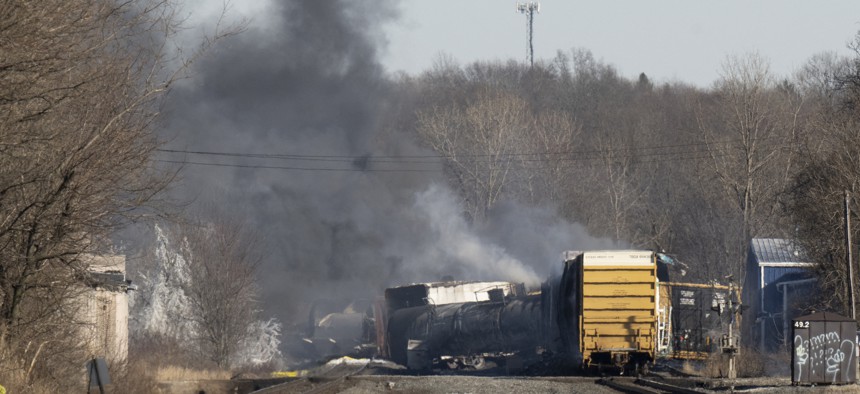Ohio Gov. DeWine Calls for Stricter Regulations on Railways after East Palestine Derailment

Smoke rises from a derailed cargo train in East Palestine, Ohio, on February 4, 2023. DUSTIN FRANZ/AFP via Getty Images
“We should know when we have trains carrying hazardous material that are going to the state of Ohio.”
This story was originally published by Ohio Capital Journal.
Gov. Mike DeWine said Tuesday that it’s “absurd” the train that derailed in East Palestine wasn’t designated a “high hazardous material train,” urging U.S. Congress to change the current regulations.
“We should know when we have trains carrying hazardous material that are going to the state of Ohio,” DeWine argued during a news conference.
The Federal Railroad Administration defines a “high-hazard flammable train” as one with 20 cars in succession or 35 cars throughout carrying class 3 flammable liquids. The fireball and massive, black plume of smoke in East Palestine came from burning the contents of just five cars carrying vinyl chloride.
DeWine, and a succession of cabinet officials, provided updates Tuesday about recovery efforts and safety monitoring. It’s a delicate balance — acknowledging the legitimate concerns of residents while also trying to allay their fears.
The governor said he’s been in touch with President Joe Biden who assured him the federal government would supply “anything I needed.” DeWine also relayed his conversation with Norfolk Southern CEO Alan Shaw.
“I asked him directly — directly — if he would personally guarantee, if he would personally guarantee, that the railroad would stay there until absolutely everything was cleaned up,” DeWine said. “He gave me his word and his commitment that the railroad would do that. They would not leave until that was done.”
Water
Early reports from state agencies paint grim picture of the consequences of the derailment and subsequent burn. Ohio Department of Natural Resources Director Mary Mertz confirmed what many have reported anecdotally on social media — the leak and subsequent fire prompted a significant fish kill.
“Very early on, we have estimated based on our sampling and modeling about 3,500 dead fish,” in four nearby creeks and streams, she explained.
That represents 12 different species, but Mertz noted none are threatened or endangered. She added that fish deaths don’t appear to be increasing.
It’s a mixed bag in terms of contamination across those four waterways as well. Tiffani Kavalec leads the surface water division at the Ohio Environmental Protection Agency. She explained Sulphur Run, the stream closest to the crash, is contaminated “but we’re confident that it is contained.”
Further downstream, tests found two contaminants in Leslie Run — butyl acrylate and ethylhexyl acrylate.
“The butyl acrylate dissipates to non-detectable levels once it gets to the North Fork of the Little Beaver Creek, and the other one ethylhexyl acrylate dissipates to non-detectable levels once we get to Little Beaver Creek.”
She noted they haven’t found any of the far more dangerous vinyl chloride in those downriver samples. Still, Kavalec explained there is a plume of pollutants from the initial fire making its way down the Ohio River at about a mile an hour.
Because of the size of the river, she explained, the plume is diluting and there’s little threat of it impacting water supplies. The Ohio River Valley Water Sanitation Commission is still tracking it, though, and alerting water systems to close intakes or take additional treatment steps.
Health concerns
State Health Director Dr. Bruce Vanderhoff tried to ease concerns about potential health threats for residents returning to their homes. Many people in the area have reported headaches, rash, sore throat, or burning eyes.
“I think that we have to look at the measured facts,” Vanderhoff said, “And the measured facts include the fact that the air sampling in that area really is not pointing toward an air source for this.”
He explained state officials are far more concerned about drinking water. The majority of nearby residents get water from the municipal system, he said, which uses deep wells that should be safe.
“There are quite a number of people who are on private water systems mostly private wells,” Vanderhoff explained. “We have strongly encouraged all of those people in private wells to get their wells tested, and that will be done at no cost to them.”
In the meantime, Vanderhoff said, residents should drink bottled water, which they can also get for free as part of remediation efforts.
As for other anecdotal reports about pets or livestock dying from exposure, state Veterinarian Dr. Dennis Summers encouraged residents to go to their local vet first, but said his office ready to assess animals’ cause of death.
“Our animal disease diagnostic lab is here to serve the livestock industries and companion owners to do necropsies and diagnostic testing for any cause of death,” he said, but warned animals must come from a veterinarian.
Accountability
Despite the state’s insistence that all available data indicates it’s safe to return home, DeWine acknowledged residents’ skepticism.
“If I lived in the community, I would be angry, too,” he said.
Pressed on whether he’d return home if he lived in East Palestine, he said “look, I think I would be drinking the bottled water,” but yes, he’d probably be back home.
As for ensuring compensation for local residents, DeWine insisted “Norfolk Southern is responsible for this problem. We fully expect them to live up to what the CEO committed to me, and that is that they will pay for it.”
“If they don’t,” he added, “we’ve got an attorney general.”
Ohio Capital Journal is part of States Newsroom, a network of news bureaus supported by grants and a coalition of donors as a 501c(3) public charity. Ohio Capital Journal maintains editorial independence. Contact Editor David DeWitt for questions: info@ohiocapitaljournal.com. Follow Ohio Capital Journal on Facebook and Twitter.





